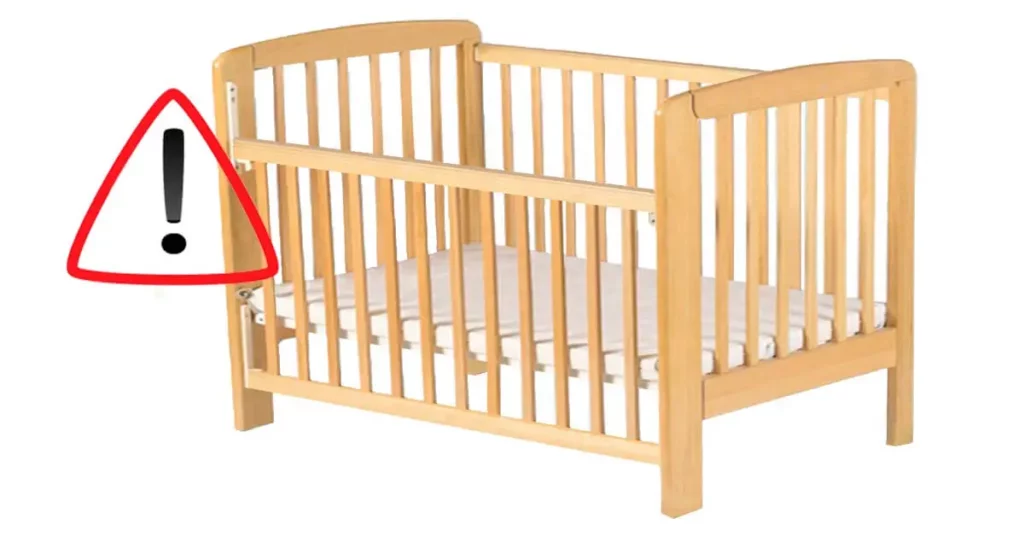
Once popular for their convenience, drop-side cribs are now known to pose a significant safety risk. In this article, I will explain the danger of a drop-side crib, why you shouldn’t use one, and list their safer alternatives.
What is a Drop Side Crib?
A drop-side crib has a side rail that moves up and down. Its design helps parents lift their babies in and out of the crib without straining. That is very practical, especially for shorter parents or those with physical limitations.
Because they allow easier access to the baby, drop-side cribs quickly became very popular among parents. However, this convenience comes with a high drop-side crib danger, as the moving parts can create safety hazards over time.
The Drop Side Crib Danger Explained
The primary danger of a drop-side crib is entrapment and suffocation. Over time, the hardware that allows the side to move can loosen or break. This can create a gap between the mattress and the crib side, where a baby can become trapped. Furthermore, the movable side can partially detach, leading to dangerous scenarios where an infant can fall or get stuck.
Statistical Data Not Speak in a Drop Side Crib’s Favour
According to the Consumer Product Safety Commission (CPSC), drop-side cribs have been linked to dozens of infant deaths and numerous injuries.
From 2000 to 2010, the CPSC recorded at least 32 infant suffocation and strangulation deaths attributed to drop-side cribs. These incidents highlight the severe risks associated with these cribs, making the drop-side crib danger a critical issue for parents to understand.
Regulatory Response to Drop Side Crib Danger
The CPSC took decisive action in response to numerous evidence regarding the risks of drop-side cribs. As a result, they established new crib safety standards that came into effect in 2011.
The new regulation completely bans the manufacture and sale of drop-side cribs. Moreover, new CPCS crib safety standards are generally much stricter. Now, all cribs must undergo more rigorous testing to ensure stability and durability, they must have more robust mattress support, there is prescribed rail distance, etc.
Alternatives to Avoid Drop-Side Cribs
By now, you already know a drop-side crib shouldn’t be on your list of baby essentials. Let me assure you that numerous safer and more convenient alternatives are available, so please choose one!
Pick a crib with a fixed side. These cribs are designed with sides that do not move, which eliminates the risk of hardware malfunctions. Some of a great alternatives for drop-side cribs are:
1. Convertible Cribs:
These cribs are versatile options that can grow with your child. As your child grows, you can easily transform a convertible crib into toddler beds, daybeds, or even full-sized beds. This versatility makes them a cost-effective and safe long-term option.
2. Mini Cribs:
Mini cribs are smaller than standard cribs but offer the same safety features. They are ideal for smaller spaces or for use as a secondary crib. Mini cribs usually have wheels and can be folded down for easy storage. Additionally, some mini cribs can also be converted into twin beds.
3. Playards (Pack ‘N Plays)
Playards are designed for easy transport and setup. They are especially useful for travel or for use in multiple locations within the home. These cribs are generally lightweight and foldable. They meet all safety standards for sleeping arrangements and are CPSC-approved.
Advice for a Safe Baby Sleep
Of course, picking a safe crib is far from everything you can do to ensure your baby’s safe sleeping space. There are many other things you should take into consideration:
1. Safety Checks
Do periodic safety checks on any crib you use. Regularly inspect the crib for signs of damage or wear. Also, ensure that the crib does not wobble and that there are no gaps between the mattress and the crib’s sides.
2. Avoid Second-Hand Cribs
While it might be tempting to save money by using a second-hand crib, I strongly advise against it. Second-hand cribs can present hidden dangers due to wear and tear or outdated designs. If possible, it’s best to invest in a new crib that meets current safety standards.
3. Proper Usage
Follow manufacturer guidelines for assembly and use of the crib. Adjust the mattress height as your baby grows to prevent them from climbing out. Do not put soft objects in the crib, place the crib away from cords and other safety hazards, and don’t smoke in the house.
Conclusion
Unfortunately, some drop-side cribs are still circulating. We cannot overlook their danger and stop discussing this topic. That’s why at BabyCribHub.com, we strive to help parents understand the risks of drop-side cribs. We hope anyone reading this article will decide against them and choose a safer alternative.
Choosing a safe crib and following the guidelines for safe baby sleep is a big step toward creating a safe sleeping environment for your baby!
For more information on crib safety and avoiding drop-side crib danger, visit the CPSC website and review their guidelines.
